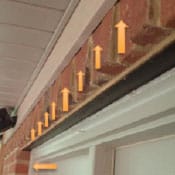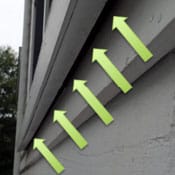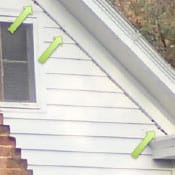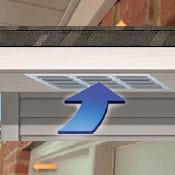Click To Call > (800) 966-7673

In the Midwest, most insects overwinter; which means they take shelter in a protected area to huddle away from the frost and snow. As it turns out the wall voids and attic space of human structures make great overwintering sites for a number of insects.
The most common overwintering insects in our area (Michigan, Ohio, Indiana West Virginia, Kentucky and Pennsylvania) are:

The Boxelder Bug is a minor garden pest during the summer. They feed on the seeds of the boxelder and other maple trees. However, it can become a nuisance in the winter when it takes refuge in homes and other shelters to avoid the cold.
About ½” in length, they are black with red markings and can easily slip in through cracks and crevices of homes and other shelters. They won’t sting, bite, transmit disease, or cause physical damage to your home or structure; although they may emit an odor and stain when crushed.

They look just like the native Lady Bug to the untrained eye, but their habits are anything but lady-like. Asian Lady Beetles will find their way into the homes or structures to take refuge in. These overwintering pests have been known to bite, emit a foul odor when crushed and taste absolutely terrible … or so we’ve been told.
 Cluster Flies
Cluster FliesCluster Flies naturally live their entire lifecycle outdoors. Unlike any other flies, Cluster flies originate as a parasite within an earthworm. Once the larvae emerge, its lifecycle continues outdoors, away from the earthworm. Once colder temperatures arrive, the Cluster Fly will seek shelter away from the elements; including clustering together behind loose tree bark, wood planks or in buildings and homes. Hence the name “Cluster” fly. If they happen to be in your house when it’s warmed by the sun, you could see them appear in your living areas. At this point, it’s too late to do anything about it, except clean up the mess.
 Leaf-footed Pine Seed Bugs
Leaf-footed Pine Seed BugsThis native outdoor pest produces just one new generation each year. The adults are about 3/4” long and dull-brownish in color. During the summer they feed on pine cones and their seeds.
When the cold winter sets in, the adults will naturally take shelter. Their first choice is to huddle under the bark of pine and conifer trees; however, they have been known to enter structures through small gaps and openings.
When their shelter is warmed by the sun in the winter, these pests can suddenly appear in mass numbers. Due to their larger size, this can be a shocking site. So just remember, this is a nuisance pest that doesn’t sting, bite or cause damage to the structures. But they do need to be cleaned up.
 Brown Marmorated Stink Bugs (BMSB), A.K.A., The new kid in town
Brown Marmorated Stink Bugs (BMSB), A.K.A., The new kid in townThe adult brown marmorated stink bugs are about ½” in length and shaped like a shield. They’re named after their appearance which is brown with a marbled pattern (marmorated).
These bugs were recently introduced to the US from Asia and have been a growing nuisance in the Mid-Atlantic States in recent years. During the summer months, the BMSB prefers to feed off vegetable crops, fruit trees and some ornamental plants which is a cause for concern as they can destroy an entire crop.
The BMSB will take refuge in homes or other nearby structures during the colder months and accidentally appear indoors when the sun warms their winter habitat. Because of their size and the nasty odor, they emit when crushed or stressed, they make their presence known. The best way to eliminate this pest once it’s inside is to vacuum and empty the bag immediately after.
Overwintering pests usually come out in the spring or during warm spells in the winter. When the sun (or your HVAC system) warms the voids of your home, the pests will become active, assuming the worse of winter is over and you’ll see them begin to emerge indoors. They enter living rooms, bedrooms, and kitchens through little cracks and crevices in the floors, walls, and ceilings. Their appearance indoors is accidental, as they are really seeking to head back outdoors. But some get confused and head further into the structure instead. If you see stink bugs, Asian lady beetles, cluster flies, boxelder bugs or pine seed bugs in the spring, chances are you have an overwintering pest problem.
The best way to take care of an overwintering pest problem is to prevent overwintering pests from entering your house in the fall.
The first step is to identify openings, gaps and other entry points pests use to get into your house. While sealing insects completely out may not be realistic, every little bit helps. In fact, with a little effort, you can make a big difference in the number of uninvited pests and rodents you entertained this winter.

The joint between two bricks is generally a little lower than the face of the bricks and, will create a gap when straight elements of construction lay across it (such as siding and molding). Here you can see a slim crack along the line of bricks where insects enter your home. Also, notice the gap under the steel plate that overtops the door. These gaps should be closed with a sealant.

Most window frames are carefully caulked and sealed on the top and sides to keep out water, but the underneath may not be caulked at all, allowing an easy point of entry for insects and spiders.

The uneven surface of the clapboard creates a gap in every board. These gaps can be caulked, but it may be easier to stuff them with foam insulating cord.

Be sure attic and soffit vents are backed with a screen if they aren’t already. If they are, check to make sure there are no holes, tears or gaps in the screen where bugs, bats, and rodents can squeeze in.

Anywhere there is a hole for vents, pipes, cables, and such, the opening should be sealed shut. Bugs can find their way into even the smallest openings. This can be done a number of ways, but stuffing gaps with flexible, breathable material are best. An old green pot scrubber works wonderfully to seal insects out, and it won’t rust away. A new scrubber will work too, but pre-used scrubbers are much more flexible.
Of course, the easiest way to keep bugs, pests, and rodents out this winter is to call Rose Pest Solutions. An inspection in the fall can go a long way towards keeping pests and mice out of your home or business this winter.
In the pest control business, we call materials used to prevent pests from entering your home “exclusion materials”. These commonly available pest-proofing products not only help prevent overwintering pests, but they’re also a simple way to keep year-round nuisance critters like mice and bats out of your home or business.
If you need help pest-proofing your home in the fall, call Rose Pest Solutions to schedule your inspection.

The Rose Home Service Program offers regularly scheduled pest control services for a single annual price, designed to identify and prevent infestations of the most common pests. Whether you're dealing with ants, spiders, or other common invaders, our Home Service Programs provide year-round protection and peace of mind.